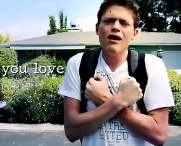Crescendo
American Sign Language music videos embody the multisensory experience of sound traveling through the air. Through the harmonization of modes, these videos make music visually accessible to those who cannot hear and to those who can. The performers’ movement and vibrant visual text activate the bodily sensation of the rising pitches and vibrations. These musical elements pulsate in rhythm to create a multisensory ensemble: I see and feel the tempo.

Figure 8: D-PAN ASL Music Video, 'Beautiful' by Christina Aguilera.
ASL music videos show the potential for continually making communication more accessible. They also remind us that no composition is fully accessible by every single body. So, they open up the possibilities for composition scholars and students to reimagine how we express ourselves and reach out to other multisensory bodies:
What other multimodal conventions can we reshape to communicate our differences or communicate to different audiences? Which excluded audience members can we include to broaden the reach of our message and benefit both designer and audiences? What modes can be utilized to convey a silent composition, an animated screen capture, or Prezi transitions to those who cannot see? What conventions can be redesigned to best convey the message of an instructional video simultaneously to kinesthetic learners, auditory learners, and visual learners?
Access does not begin or end with a single composition. The crescendo of the movement gradually intensifies as we continually rise towards improving the accessibility of any multimodal composition.
Let us synchronize towards more accessible multimodal compositions and pedagogies that recognize both the limitations and the potentials of communicating in different ways.
Let us continue to design and redesign accessible multimodal practices that reach out to more bodies, more senses, more differences.
The crescendo is only intensifying…
NEXT: References
